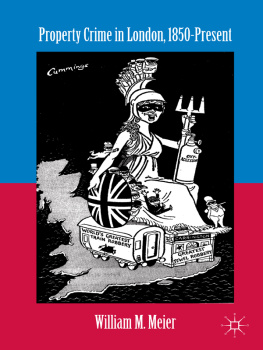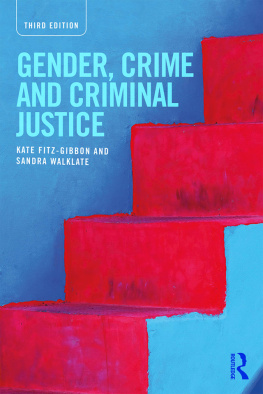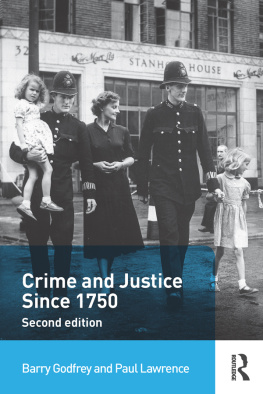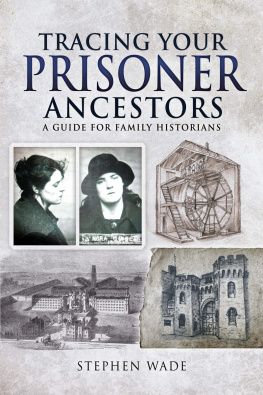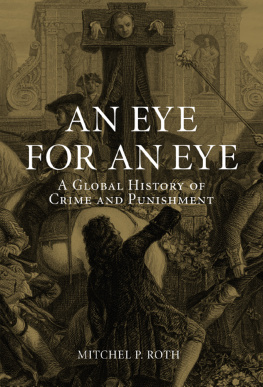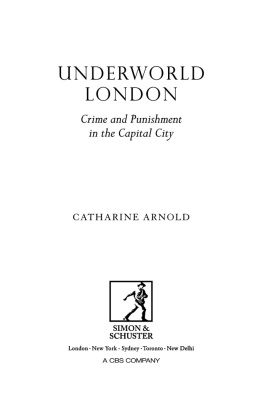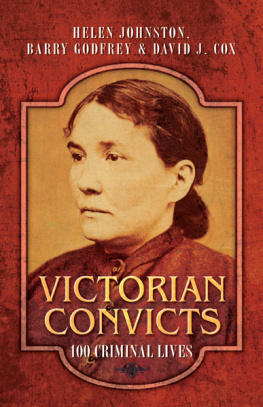PROPERTY CRIME IN
LONDON, 1850PRESENT
PROPERTY CRIME IN
LONDON, 1850PRESENT
WILLIAM M. MEIER


PROPERTY CRIME IN LONDON, 1850PRESENT
Copyright William M. Meier, 2011.
All rights reserved.
First published in 2011 by
PALGRAVE MACMILLAN
in the United Statesa division of St. Martins Press LLC,
175 Fifth Avenue, New York, NY 10010.
Where this book is distributed in the UK, Europe and the rest of the world, this is by Palgrave Macmillan, a division of Macmillan Publishers Limited, registered in England, company number 785998, of Houndmills, Basingstoke, Hampshire RG21 6XS.
Palgrave Macmillan is the global academic imprint of the above companies and has companies and representatives throughout the world.
Palgrave and Macmillan are registered trademarks in the United States, the United Kingdom, Europe and other countries.
ISBN: 9780230114906
Library of Congress Cataloging-in-Publication Data
Meier, William M., 1980
Property crime in London, 1850-present / William M. Meier.
p. cm.
Includes bibliographical references and index.
ISBN 9780230114906
1. CrimeEnglandLondonHistory. 2. Justice, Administration ofEnglandLondonHistory. I. Title.
HV6950.L7M49 2011
364.1609421dc22 2011015015
A catalogue record of the book is available from the British Library.
Design by Newgen Imaging Systems (P) Ltd., Chennai, India.
First edition: July 2011
10 9 8 7 6 5 4 3 2 1
Printed in the United States of America.
ACKNOWLEDGMENTS
LIKE MANY OF THE CRIMES DESCRIBED HERE, this book was a team effort. I started this project as a dissertation at the University of Wisconsin-Madison, where Mary Louise Roberts, Suzanne Desan, Johann Sommerville, and Jeremi Suri each shaped my thinking about history and crime. I owe special thanks to my graduate advisor, James S. Donnelly, Jr., for his guidance, encouragement, and painstaking editorial assistance. For its material and moral support I am also greatly indebted to the Department of History at Miami University, which was the cradle of my undergraduate historical studies. My professors at Miaminow, happily, my colleaguescontinue to inspire and guide my career. Thanks in particular to Dr. Andrew Cayton, whose comments and kind support have assisted me in bringing this work to completion. Of course, none of this would have been possible without the steady support of my parents, Kathy and Bill Meier, who indulged and paid for my love of history. I regret only that the following pages are meager recompense for their investment.
Above all, I owe the most heartfelt gratitude to my wife, Courtney. Her love and unwavering support were indispensable to this project from start to finish. She has brought me great happiness as we have made a home, a family, and a life together. This book is dedicated to her. It is our accomplishment.
INTRODUCTION: CRIME THERE WILL EVER BE
THE LONG-RUNNING DECLINE IN THE STATISTICS FOR THEFT AND VIOLENCE in England and Wales from approximately 1850 prompted unfaltering optimism among late Victorian policymakers, the press, and the public. The Times cheered the governments moral budget (i.e., the criminal statistics) for 1896, which demonstrated that since the beginning of Victorias reign, crime has decreased, is decreasing, and will probably still further decrease. Given the creation of professional policing and a national prison system in the previous decades, in addition to the introduction of social and educational reforms, how, contemporaries wondered, could crime not but diminish? At the present rate of decrease, declared the author overconfidently, the professional burglar and pickpocket will soon disappear.
Historians have since corroborated this sanguine outlook on law and order. V. A. C. Gatrell, in his extensive statistical study, confirmed the decline in theft and violence in England and Wales between approximately 1850 and 1914.
Amid the enthusiasm for penal progress, however, Sir Robert Anderson struck a cautionary note. During his tenure as assistant commissioner of the Met from 1888 to 1901, Anderson feared that complacency andwhat
This study explores how and why the English miracle was so spectacularly reversed that Britain was transformed into a high-crime society by the end of the twentieth century. The following analysis grapples with questions central to historians examination of crime: What caused crime, and how has it changed over time? Who became a criminal, and why? Was there a criminal class? How have criminals compelled the state to create or adjust its institutions, including the law, police, and penal system? To answer these questions, I investigate the evolution of six different types of crimeburglary, shopbreaking, shoplifting, confidence tricksterism, robbery, and drug smugglingeach of which represents a distinct phase in the expansion of criminal activity since 1850. None of these offenses was novel in the modern period; but what was incontestably new was the sea change in the forms, functions, and volume of these crimes as they evolved in symbiosis with the expanding power of the state and the changing social and economic landscape of modern Britain. Thus, while Andersons statement Crime there will ever be, rings true, it is also the case that specific manifestations of crime are symptomatic of and contingent upon ever-changing social, economic, political, and penal conditions.
The following study is the first scholarly attempt at an expansive interpretation of changes after 1850 in property crime and the criminal justice system in the London metropolitan area. Until recently the twentieth century in British criminal history has been neglected; the standard text, Clive
In recent years, historians have begun to fill in the overall picture of the twentieth-century criminal landscape. Broadly speaking, the current historiography on post-1850 crime and criminal justice can be grouped into institutional and cultural approaches. On the one hand, there are extensive studies of such criminal justice institutions as the police;attention to the development of institutions and to the fear of crime is welcome, it has done little to resolve fundamental questions of interest to the social historian. How much crime was there? What type of people committed these offenses, and why? Were sensationalized crimes typical or atypical? Why was (and is) there so much crime in Britain? Let us take up each of these questions in turn.
* * *
Historians sharply disagree about the accuracy of English criminal statistics and thus about the overall level of crime since the first national police returns commenced in 1857. In his pioneering study Social Aspects of Crime in England between the Wars (1940), Hermann Mannheim called attention to the range of factors that limited the accuracy of criminal statistics in reflecting the state of crime: legal definition, criminal procedure, police activity, and public opinion each in their own way tend to limit what researchers can deduce from statistical study of crime, especially when comparing different historical eras. Positivist belief in the accuracy of the criminal statistics was also the foundation for Radzinowicz and Hood to construct their theory of the English miracle.
However, the last two decades have witnessed greater skepticism about the criminal statistics. In general, scholars point out that statistics were products of complicated procedures and that they tell us more about the operation of the criminal justice system than about the true level of criminal activity; one criminologist concludes that social and legal alterations in defining crime render the idea of a true total of crime useless.
Next page
